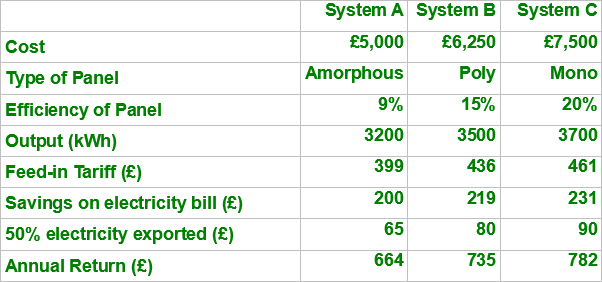What is the cost for solar PV panels?
Due to growing competition and manufacturing costs falling, solar panels have significantly reduced in price by around 40% since they were introduced. This is good news as it means its now possible to get a fully functioning solar PV system installed on your roof earning you money from about £4000 to £7000 depending on the size of your roof. You can also receive money from the government and get a payment for every unit of energy you produce and for returning back to the grid that you don’t use.
What makes you eligible for solar PV feed-in tariff?
The government launched what is known as the Feed in Tariff in an attempt to lure more people into installing solar PV as it pays households for all electricity generated by their solar PV system they have installed. Unfortunately now the government have significantly cut the rates and payments and refuse to pay for the systems and their installation. The extra money you now actually receive is still a bonus if you fancy generating you own power.


It is necessary to use as much as possible the electricity your generate in your house if you want to get the maximum returns from your solar PV installation. This means that as you are using only the electricity you are actually generating its not necessary to purchase electricity from your energy supplier so a saving of 12.5p/kWh is achieved. You only get paid small amount of this figure if the electric you generate is exported but its not the primary reason for exporting your electricity.
Recent leaps in battery developments means it will not be long before households will be able to store the unused energy they produce in storage batteries so as they can use it at a latter time.
Examples of financial figures in solar PV
If you are classed as using energy at 75% or above then to be honest you are spending all or most of your time at home on a constant basis each week. The more typical mean basis user is at approximately 50% use of the energy they produce and then they export the remaining 50% back to the grid. The table below actually shows the figures and differences between using the electricity in your home compared to exporting it.
Based on percentages used in households compared with the amount they export, a 3kWh system fitted onto a new house with a high-energy efficiency rating should be approximately 90% efficient and produce approximately 2700 kWh of energy. The average household is expected to use about 4800 kWh per annum.
Examples in percentages of power used in the household & the percentage of power exported back to the national grid:

These figurers may change; they are just an example and were calculated in March 2017. To get current figures please click here
What affects the cost of a solar PV system?
The actual size of the installation and the quality of the solar panels used can have an effect on the initial cost of the solar PV you choose for installation.
Size of panels and installation used
Lets firstly talk about the size of the installation. The bigger the system the greater amount of power it will generate. The mean average at present installed by homeowners is a 3.5-kilowatt system and rating it at 90% it will generate about 3150 kWh of power dependant on the weather and sun levels present but as we already know an average household uses about 4800kWh.
The size and amount of panels you decide to have fitted will more than likely be dependant on the surface area and size of your roof or the actual amount you are able to afford to buy. There are a number of supplies out there and they do vary in cost for the installations. Its always prudent to get more than one estimate and ensure they are MCS-accredited so as to qualify for the Feed in Tariff.
If your having any problems or for more information please feel free to contact Acorn Roofing Solutions (ARS) 01752 201077 where a member of our staff will be happy to talk with you and give you some free advice.
The quality of the panels used
Lets now talk about the quality of the solar PV panels. Solar panels are not all alike. There are 3 main types on the market:
Monocrystalline solar cells
These cells are grown from single crystals placed in isolation. The panels are classed as the most efficient rating at 15% to 22% but unfortunately the are the dearest panels on the market to purchase. Polycrystalline solar cells
The panels are considerably less expensive than the monocrystalline system but it has a drawback being their rated efficiency is also much lower than the monocrystalline system coming in at only 13% to 17%.
Amorphous solar cells
By far the cheapest solar cell panelling on the market, Superb for the UK as it’s more efficient in low light conditions. However, they are the worst when it comes to the rated efficiency at just 9% overall.
How each system's efficiency is calculated
Each system’s efficiency is calculated by the amount of power in watts are generated per square meter. So if one square meter of panelling produced 1000 watts it would be 100% efficient. So a panel rated at 20% will produce 200 watts per square meter.
As the efficiency rating increases the power produced increases per square meter and usually the price to purchase increases too. The cost for your installation is dependant on the design of panel you choose to be installed. This means a 4Kw system may cost as much as £7500 or as little as £5000.

If your having any problems or for more information please feel free to contact Acorn Roofing Solutions (ARS) 01752 201077 where a member of our staff will be happy to talk with you and give you some free advice.
Your solar system paying you back
A typical choice to have installed is a 3.5-kilowatt PV solar array fitted to your roof. This will return you about £650 to £700 per annum from the Feed In Tariff. So a £6000 pound system should take approximately nine years to pay you back. The payments you receive are all tax-free and are guaranteed for the period of twenty years. They are also linked with RPI increasing the payments as time goes by.
As with most things in life, energy prices are anticipated to increase over time so the amount you save for every kilowatt of power used in your house is going to increase and could easily double in five years. Once your money has been returned further money made is a bonus and your now in the profit zone. This is when you will get eleven years of payments made quarterly and paid directly into your account all tax-free.
Maintenance to your system
As with most things in life, to maintain the correct running of an appliance or system maintenance is required. The panels will need cleaning twice a year to ensure they are clean, free from dust and dirt, which would hinder their performance.
Inverter replacements
Nothing lasts forever; the inverters in your system have a usable life of about 10 years before they will need replacing. So you will go through two sets with a panel lifespan of 20 years. The cost to replace these will set you back approximately a grand. So ensure you take all this into consideration when getting estimates for an installation.
Insurance for your system
Your home insurance will cover your system but ensure you tell them that you have a system fitted and the design of system you have. Expect your premiums to increase when you add this to your policy.
Planning permissions
Planning permission is not usually necessary, but if you are unsure because you live in a place such as a world heritage or conservation area then speak to your local authorities building control and planning to ensure you stay the right side of the law.
Thinking of having a solar PV installation?
If you’re considering having a solar PV system fitted to your roof or for more information please feel free to contact Acorn Roofing Solutions (ARS) 01752 201077 where a member of our staff will be happy to talk with you and give you some free advice.
Cost & guide for a 4 kilowatt solar PV System
A 4-kilowatt system will cost about six grand produce a saving of approximately eight grand over a twenty-year period. That works out to be a two grand profit return. A 4-kilowatt system is generally picked and most commonly installed into residential properties delivering a very good return on the investment made.
4kW solar PV systems
One of the most popular PV systems on the market especially designed for residential properties is a 4 kW solar system. This system will usually cover the necessary energy demand and requirements for a family home containing up to 4 residents. The installation requirements on your roof will need around 24 to 28 sq./meters of obtainable roof space.
If roof space is limited there is on the market higher efficiency 4kW system that will need less space for installation but the cost to purchase is more expensive.
How much will a 4kW system make?
When you install solar paneling you will earn money in three separate ways:
Energy bill saving
As energy is being produced free from your home to power your home you don’t draw energy from your supplier so you will make a significant saving to your annual energy bill. On average a typical 4kW system will reduce your energy bill by approximately 50%.
Generation tariff
You get paid for the electricity you produce, even if you have used some of this energy to power your home it doesn’t matter, you still get paid for it. It is the generation element from the Feed in Tariff. The payments to you will carry on for 20-years and it is the primary reason why having a solar PV system is so profitable.
Export tariff
All electricity you don’t use you again get paid for but it get routed automatically back into the power grid system. This is the Export Tariff element of the Feed in Tariff. It doesn’t end there, if your property has a smart meter, you will get paid for Exports of energy up to 50% of the energy you produce as it is an impossibility for energy companies to correctly monitor and police it. This is great because it doesn’t matter if you use all the energy you have produced as you will still get your export payments and will get these payments for 20-years.
Examples of 4Kw current feed-in tariff rates:

The table set out and shown here is the present Feed In Tariff and the predicted future rates publish by the government.
What will it earn me and how much will it cost?

The table set out and shown here explains the usual amount of return from a 4Kw system and the cost implication to have installed related to the other systems used for residential homes.
Every quarter the Feed In Tariff is reduced. If you are thinking of having a solar PV system installed, we would recommend that you did it sooner rather than later so as to qualify for the most current higher Tariff rates. As soon as you get your system registered you can sit back and benefit from the same tariff as it is frozen for the next 20-years.
How can I tell if a 4-kilowatt system is right?
You must take into consideration 4 facts when it comes to choosing the correct solar PV system or a 4kW system:
You want a high return for your investment
It is possible to earn a profit of about £2000 over a 20-year span with a 4kW system installed. This is why it is the common choice for most residential properties and most profitable as it qualifies and pays out the highest from the Feed In Tariff.
You are a high to medium user of electricity
A 4kW system will easily provide all the power you require for a typical family of four
You have enough roof space
A 4 kW system will need about 24 to 28 square meters of available, usable roof space.
You have lots of roof space due to having a large property
If you have a large property with lots of roof space it is an option to consider having a 5kW system instead of a 4kW. The Feed In Tariff is slightly less but due to the extra power you will generate you will probably find that you will earn more overall. Also the cost to install it may be a little more expensive than a 4kW but over a 20-year period your investment returns may well be a lot higher.
Key points to remember when having a 4-kilowatt system
To get the best results you will need to have a roof space that is shade free for a lot of the day, and have about 24 to 28 square meters of this roof available. The inverter is usually placed in the loft so ensure you make room for this. Your inverter converts the light of the sun into usable energy you can utilize. Make sure the installation company you choose carries out a detailed survey of your roof and structure to safeguard it is appropriate for the installation of solar panels. The installation company has a legal obligation to check that its ok. 99 times out of 100 it will be fine as most roofs in the UK can easily support solar panels. In the South of the country southeast and southwest facing roofs deliver best results. East and west facings roofs can still provide satisfactory amounts. Make sure you use a MCS accredited installer to ensure you qualify for the Feed In Tariff scheme.
Thinking of having a solar PV installation?
Get a minimum of three estimates before actually committing to your chosen company. Ensure they are MCS accredited and ask them for a complete breakdown in costing. Join lots of others now and let your home earn you money.
If you’re considering having a solar PV system fitted to your roof or for more information please feel free to contact Acorn Roofing Solutions (ARS) 01752 201077 where a member of our staff will be happy to talk with you and give you some free advice.
Renewable Energy
Technologies like solar panelling reduce your properties CO2 emission levels and provide another choice rather than fossil fuels.
Solar panels for hot water
An average good sized solar panel system will provide approximately 50% to 70% of hot water requirements required for a domestic home and the boiler will step in to provide the rest. This can offer a sensible saving cost for hot water heating.
Solar panels work by harnessing the power of diffused and direct sunlight converting the energy to heat so as to heat water up used in your home. Solar panel are designed to work in conjunction with an existing heating system storing, a bit like an electric car with a petrol engine, storing the hot water it produces in a cylinder. The existing cylinder is replaced with a new cylinder containing two heat exchanger coils. The boiler powers one coil and the second is powered from the solar panelling.
Solar panels are the perfect team player to hook up with a new condensing boiler. Their is a number of different models on the market both oil and gas. The system will require a separate cylinder for storing the hot water it produces. When used together they offer an effective efficient system and can save you money too, all in all a good combination.
Air to air heat pumps
An air-to-air heat pump is a heating and cooling all in one system, which provides annual all year comfort. They convert the external air into heat then circulate the warm air around your home providing a acceptable temperature all around your home. They can also work as an air purifier and cooler if using the correct technology.
Air to water heat pumps
Air to water heat pumps can offer significant savings when compared with conventional heating systems.
Air source heat pumps can be the sole source for hot water and heating for the domestic home, while air to water heat pumps use constant available energy in the air using a refrigerant circuit that permits the temperature to be increased to a level suitable for hot water or heating for the domestic home.
Renewable energy
Technologies like solar panelling reduce your properties CO2 emission levels and provide another choice rather than fossil fuels.
Why Choose Acorn Electrical & Mechanical
We are based in Plymouth Devon so we cover the complete South West. We have a team of skilled electricians who are passionate about their work and have been doing it for over 15 years.
Our team offers:
Please feel free to call us for help or advice.
If you are interested in booking a survey for any of our services or just a safety check, please contact Acorn Electrical & Mechanical (AEM) and a member of our team will be happy to help or advise you. CALL now on 01752 201077 or 07779 777965

